Louvre; one of the most famous art museums of the world holds a stunning variety of art through every century….of course the jewel in its crown is Da Vinci’s Mona Lisa. The history of Louvre dates back to 1546 when Francis I who was a renowned art collector had his old castle destroyed to build a more beautiful version of it. The remnant of this castle is now a part of Louvre.
Almost every French monarch has added to the grand structure ….notable examples being Louis XIII and Louis XIV (this was when a large portion of historical artefacts were acquired).
The Colonade portion of the Louvre was exquisitely designed by famous architects Claude Perrault and Charles Le Brun. Louvre officially became a museum in 1682 when Louise XIV moved his royal court to the Versailles palace. The Grand Gallerie was completed post this and in 1793 the Musee Central des Arts opened to the public.
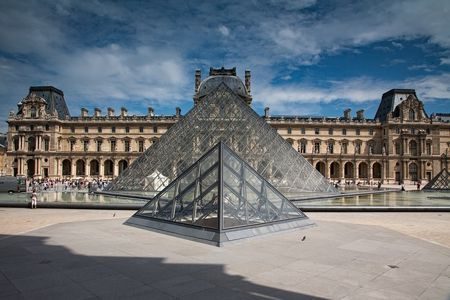
The Cour Carree and northern wing were opened under the Napoleon rule and in the 19th century the complete version of Louvre was finalized. Between 1980 and 1990 major renovation work took place in Louvre which made the museum more accessible and added an underground space with storage areas, parking, offices and shops along with a tourist depot and auditorium. I.M Pei’s spectacular pyramid entryway to the Louvre is a notable addition. The latest addition to Louvre was in 1993 when the Richelieu wing was opened to the public (in honor of the 200 birthday of the museum).
Structure & Layout
The main entrance of the Louvre is the magnificent 22 meter high glass pyramid in the central courtyard that was designed in 1989 by Leoh Pei. 679 perfectly crafted glass panes make up this pyramid and light up the hearts of the tourists waiting in line here.
The Pyramid allows direct access to underground Cour Napolean (Napolean Hall) where there is the ticket office and help desk. Once you enter the Louvre you can choose to go any of the first floor of the wings (Denon, Richelieu and Sully) or to take the escalator down to admire the foundations of the Louvre Palace. Here there are moats and dungeons and the Salle Saint Louis that’s filled with rib vaulted support columns.
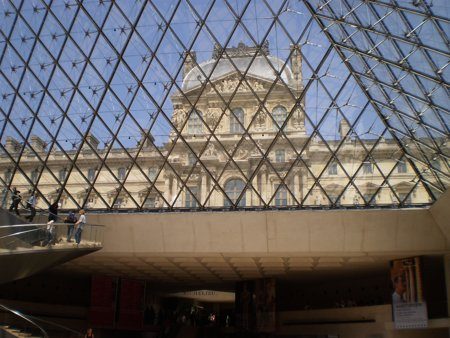
Each wing has galleries laid on 4 floors and all wings are linked. More than 60,600 sq. meters of space are dedicated to only holding the permanent collections. More than 380,000 objects and 35,000 works of art are a part of Louvre and they include paintings, sculpture, archeological exhibits, jewelry, models, drawings and other objects.
The Louvre building is an ornamental structure that’s huge in scale and some of its halls are an attraction in itself. Salle des Caryatides is a gorgeous reception hall created for Henri II and the equally opulent but differently themed Chambre de Parade du Roi (room 25 Egyptian Antiquities) was where Charles IX and Henri III spoke to the court each morning.
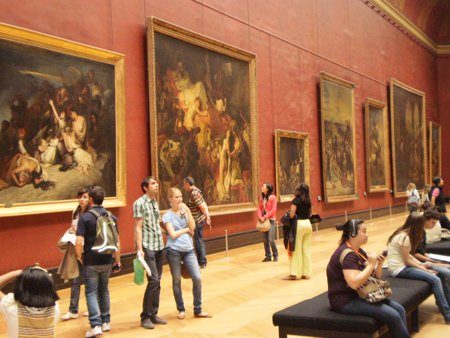
The Royal apartment of Louis XIV or Salle des Sept Cheminees (room 74 Greek and roman antiquities) and the Napolean Apartments including dining rooms and Grand Salon (use Lefuel staircase to reach Richelieu wing) are luxurious works of art that are as important as the museum collections. The Gallerie d’ Apollon or the main reception hall of the Louvre has stunning ceiling painting “Apollo slaying the Serpent”.
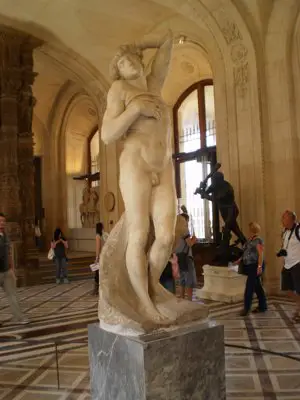
A part of the 23 hectare garden (Jardin Tuileries) stretches between Musee du Louvre and Place de la Concorde and naturally visitors who visit the museum explore the gardens too. A 6.2 hectare beautiful garden (the Carrousel gardens) stretches between the 2 wings of the Louvre…this has over 20 exceptional statues… Towards the east along rue Rivoli are 3 tiny gardens; Oratory garden, Infanta’s garden and Raffet garden (not open to public).
Most people are unaware of the fact that the Louvre has an underground auditorium that hosts regular classical music programs.
The Best of Louvre Collections
Right now all types and periods of European art till the 1848 revolution are housed in the Louvre. Paintings and artefacts that were created after this date are a part of Musee’D Orsay after its 1986 inauguration.
The 15th to 16th century painting collections of Louvre are unparalleled…so spend a sizeable chunk of your time admiring them. The most noteworthy elements of each wing of the Louvre are detailed below though the museum contains many more marvelous works of art.
Denon Wing
The rooms 75 to 77 on the first floor Denon wing is devoted to French history and contains the best curated works sourced by French monarchs. Watch out Jacques Louis David’s “Coronation of Napolean”, Delacroix’s “Liberty leading the People”, Gericault’s “Medusa’s raft” …the paintings here symbolize important events of French history in huge sweeping canvasses.
The same room which holds Coronation of Napolean also hosts another important painting by the same painter Jacques David “Oath of Horatii “. A large central hall connects the twin chambers of French Romantic and Neoclassical periods and that has a gift shop. Look up at the ceiling…it has an amazing skylight with stucco figures created by Francisque Joseph Duret.
The first floor of the Denon wing is equally noteworthy with rooms 1 to 3 containing luscious frescoes by Botticelli and the central room containing the famed Lisa Gheradini portrait (Mona Lisa of course!). Usually there are a swarm of people taking selfies with Mona Lisa here and strict barricades prevent getting anywhere closer than 10 feet of her (applicable for other artworks too).
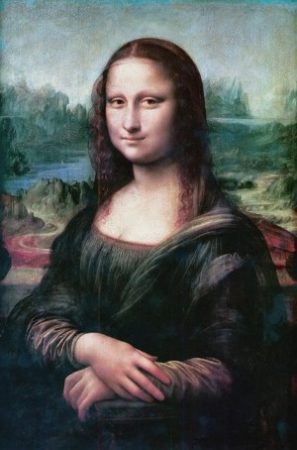
Room 3 has an important piece “the coronation of the Virgin” by Guido di Petro…a 1430 dated painting sourced from Florence. Don’t waste much time here and check out Room 5 that contains 5 famous Leonardo paintings plus “Potrait of Baldassare” by Raphael. Right behind there are lovely paintings like Titian’s “Pastoral Concert”. Room no 6 has the Veronese creation “the Wedding Feast at Cana”; a 1553 dated painting that has 100 odd figures in it.
The Apollo Gallery Room 66 of Denon wing first floor has huge arches and amazingly intricate frescoes… the whole chamber seems to have been dipped in Gilt. Checkout the French coronation jewels on display here and you will understand the lavishness the French monarchs were used to. The coronation crown of Louis XV has sapphires, rubies, diamonds and pearls and is the most extravagant of the lot.
The Regent diamond is displayed separately. Go to the room 74 and you can see Diademe de la Duchesse (Anglouleme’s tiara) that’s a blindingly jeweled piece decorated with emeralds and diamonds. The Coronation crown of Eugene tops the list… it has 2480 diamonds and 56 emeralds!! Paintings by Charles Le Brun and French romantic masters Eugene Delacroix on the ceilings have made this the most beautiful chamber in the Louvre.
The Islamic Galleries on the ground floor and lower level (opened in 2012) are also spectacularly beautiful. The 2 underground floors have a golden wavy roof known as “Veil” and the spaces are exquisitely decorated. Watch out for 17th century dagger with horsehead hilt (sourced from Rothschild collection) and 14th century hammered bowl called “Saint Louis Baptistry”.
Another set of rooms worth exploring in the Denon wing are 22 to 28 that were originally the summer apartments of Anne of Austria (Louis XIV’s mother). The ceilings here have vivid paintings by Baroque painter Giovanni Romanelli. Ancient pure white sculptural work by the Greeks and romans are housed here creating a dazzling contrast with the jeweled walls.
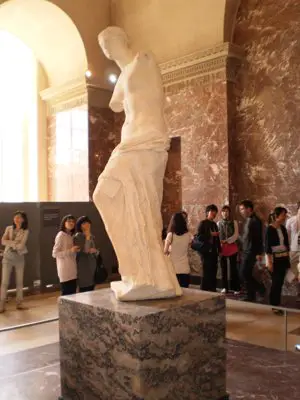
Sully Wing
Sully wing ground floor rooms 16 and 17 contain exquisite Hellenistic stonework. Room 17 has Venus de Milo (sourced from the Greek island Milos) and Sleeping Hermaphrotidos. The Daru staircase will lead you to one of the museums best pieces “winged victory of Samothrace” that’s actually a depiction of winged Goddess of Victory (Nike).
Ground floor of the Denon wing has many roman sculptures like Michelangelo’s Dying Slave , rebelling slave and Antonio Canova’s “Psyche revived by Cupid’s Kiss”…probably the most tender and romantic composition in the Louvre. Room 24 has a very interesting piece “the Cheat with Ace of Diamonds” that’s painted by Georges de la Tour…observe it carefully and you will find an entire story hidden there. Sully Wing Room 60 is full of Dominique Ingres neoclassical paintings that are sensuous and different from the romantic works. Look out for the “Valpicon Bather”, “Turkish Bath” etc.
The rooms 38 and 39 on the second floor of the same wing have a beautiful collection of still life paintings by Jean Baptiste …the most famous of which is “The Ray”. The room 39 has a collection housed in a stunning glass wall. The French and Italian Paintings sections are interconnected so you can explore these in one shot.
The Egyptians Antiquities section is on the ground floor Sully wing rooms numbered 1 to 14….there are 7,000 Egyptian artefacts displayed here with an overwhelming variety of sarcophagi (most of it in room 14). Enter through the ground level of Pavillion de L’Horloge and you can see the 12 ton heavy Sphinx of Tanis (human head lion tail). Look out for the exquisite model ships in room 12 and the mummy cases in Room 14. The Pavillion de l’Horloge/ Medieval Louvre underground chambers are well worth a visit…visitors will feel as if they are sifting through a moat.
Richelieu Wing
The Napolean III apartments in Richelieu wing (rooms 82 to 92) were created by Louis Visconti and Hector LeFeul in 1850’s… these are a testament to the extraordinary high standards of living of Napolean. Room 87 has the majestic Grand Salon with rococo furniture and fresco ceilings and an abundance of red velvet chairs.
The ground floor and lower level have the Marly court which have white marble and stone work that’s part of an outdoor courtyard between the Napolean court and Rue de Rivoli. The glass ceiling here is very beautiful… it’s created by Mr. Pei (creator of the Pyramid). On the same wing second floor rooms 6 to 12 contain Dutch and Flemish masterpieces that have many famous pieces like “Ship of fools”, “portrait of Erasmus”. Room 8 has a particularly evocative painting “portrait of artist holding a thistle” by Albrecht Durer.
Richelieu wing room 38 has another jewel ….”The Lacemaker” by Jan Vermeer. Cour Marley courtyard adjacent to the Richelieu wing has the work of famous sculptor Guillame… giant Carrara marble structure “Chevaux de Marley” that showed two lively horses being restrained by their grooms (demigods Pollux and Castor”).
If you get time…do check out the interactive media experiences of the Louvre that will let you possess a better understanding of art? Some examples include the Egyptian Antiquity experience, Spanish painting masterpiece experience and the sculpting the body experience (specially meant for the visually impaired) at DNP Museum lab section. However events keep changing and you need to keep an eye on the Louvre website.
Open Hours, Tours & Tickets
The Louvre museum is closed every Tuesday and on January 1st, May 1st, May 8th, December 25th.
On Monday, Thursday and Saturday, Sunday and on all French national holidays the Louvre is open from: 9 a.m.–6 p.m.
On Wednesday and Friday the Louvre is open from: 9 a.m.–9:45 p.m.
Rooms begin closing at 5:30 p.m., and at 9:00 p.m. (respectively) so plan to be through with your museum exploration before that.
January 2019 onwards, all visitors would be able to explore the Louvre free of charge on the first Saturday of each month from 6 p.m. to 9:45 p.m.
The Louvre is incredibly crowded at all hours so expect the free slot to be swarming like a beehive. The best time to see the Louvre is in the morning or at night openings.
The individual visitor ticket for the Louvre costs 17 euros. An audio guide can be booked that helps visitors see and understand the art collections intelligently… this costs 5 euros. A guided tour of the Louvre can be booked with a museum guide (duration 1.5 hours). Group tickets for a group between 7 to 25 people can also be bought but groups need to bring their own guide.
People under 18, with disabilities or on economic support (living in European economic region) can see the Louvre for free.
You can buy Louvre Museum tickets online (including skip the line tickets) or book tours from this Louvre booking site of Viator. For skip the line ticket you will get access to a particular slot for a particular day and can skip the queues. However if you miss the slot, you cannot use the ticket again.
The museum offers two guided tour in English per day… these can be booked two weeks in advance by phone. Guided tour booking Phone number: 00 33 140 205177
You can also buy tickets from the Louvre ticket machines in the Carrousel du Louvre shopping center…the Civette du Carrousel tobacconist on 0 level also stocks Louvre tickets.
Many of the Paris city passes offer discounts on Louvre ticket or a skip the line option. Paris city pass and museum pass (the best of many passes) have open tickets with dedicated entry to the museum so there is no fixed slot that you have to compulsorily take. These passes combine most city attractions and all museums (respectively) and cost between 50 euros to 150 euros depending upon what option you are choosing (there are 2/4/6 day variants). These offer huge savings but are only worth it if you see most of the attractions and have sufficient time on hand.
If you are museum watching with kids then ask for strollers/ baby carriers from the visitor assistance area. There are many activities aimed at kids and many art lectures for adult but they are all mostly in French. Buy the Museum guide from the bookshop…you might find it useful!! Some galleries have information sheets in English but the captioning quality in the galleries is poor making buying the audio guide at least a compulsory thing.
Seeing the whole of Louvre requires at least 3 full days. However if you have less time on hand, choose the kind of art you are interested in and see only relevant rooms and pieces, a guide may help in this case. If like most tourists you are interested in only the cream of museum attractions then read the section ‘The best of Louvre collections’ of this article carefully. The Louvre suggests many themed visitor trails like “Daily life in Egypt”, “Masterpieces”, “Still Life Paintings” etc.
Nearby Attractions & Dining Options
The Louvre and the Tulleries Garden are home to at least 15 different kinds of restaurants and cafes so there is no need of looking for alternative places to eat. Right at the center under the pyramid is Goguette serving expensive and artistic French casual food. There is a Starbucks counter right next to Goguette and the Comptoir du Louvre offering snacks and pastries at competitive prices.
The Denon wing first floor has Café Mollein …this one has a terrace overlooking Carrousel gardens (open only in summers).
There is Paul (French bakery in the Carrousel Gardens) and Takeaway counters of Richelieu and Denon inside the museum complex. The open air brasserie Terrasse de Pomone and the Amorinno ice cream stall in Tulleries garden are other options.
A visit to the Tuileries garden and Place de la Concorde follows naturally ….here you will find Luxor Obelisk (Charles X gifted it to Mehmet Ali Pasha) Logically, an entire day will fall short if you plan to see the Louvre, Tulleries garden and the Carrousel gardens and shopping mall in detail but most visitors do combine a visit to all three places.
Download the Louvre app on your phone…it will help you with navigation as well as spotting facilities like restaurants and public toilets. The Lovelock Bridge (all locks are now cut off and replaced by local art) is just 0.22 miles away and the Musee des Arts Decoratifs is 0.14 miles away.
Location & How To Reach
The nearest metro station to the museum is Palais Royal Musee du Louvre that’s reachable by metro lines 1 & 7
Bus numbers 21, 24, 27, 39, 48, 68, 69, 72, 81, and 95 stop in front of the Pyramid du Louvre. If you are arriving via car then park your vehicle on the underground garage on Avenue du General Lemonnier (open from 7 a.m. to 11 p.m. everyday)
The lines at the main ticket office at Pyramid du Louvre are the longest so you can use the Carrousel du Louvre entrance from the metro station that usually has shorter lines. You can also enter from the Richelieu passage off Rue de Rivoli or the Portes des Lions (far south east Denon wing of Museum)…this is the least crowded entrance point (watch out for the twin lions that mark the entrance gate that connects Tuileries garden to the Louvre).
Rue de Rivoli, 75001 Paris
Email: [email protected]; Phone: +33 (0)1 40 20 53 17 (phone lines closed on Tuesday)
Official Website
 A travel addict. Still celebrating the day when he quit his high-profile corporate job to pursue his passion for travel writing.
A travel addict. Still celebrating the day when he quit his high-profile corporate job to pursue his passion for travel writing.